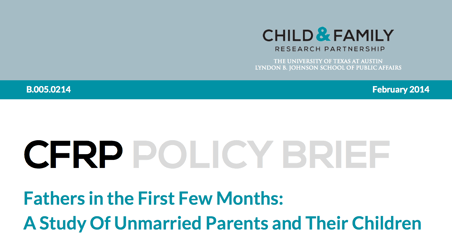Last week I wrote about research that shows how important dad's presence is at the birth of his child.
Specifically, his presence increases the likelihood his child will be a healthy newborn. It also means mom is likely to be healthier.
On the other hand, when dad is absent, baby and mom are less likely to be healthy.
But what happens after the birth? How involved is dad at the earliest stage of his child's life? Those are two vital questions because, as we know, a child with an involved dad is more likely to grow up healthy physically, emotionally, and socially.

Another excellent research brief from the Child & Family Research Partnership at the University of Texas at Austin reveals the proportion of dads who are involved and not involved. It also reveals the factors that predict a lack of involvement.
Analyzing data from the same sample of 800 unmarried Texas moms that pointed to the importance of dad's presence at birth, researchers found that 27% of unmarried dads were completely uninvolved in their child's life a mere three months after their child's birth. (For details on how the researchers defined and measured involvement, read the research brief.) The good news, of course, is that nearly three quarters of the unmarried dads were involved.
Nevertheless, that's more than 200 children with an absent dad.
The researchers discovered that the following five factors led to a lack of involvement:
- Family violence: Dads with a history of family violence were more likely to be uninvolved.
- Short relationships: Dads who dated the child's mom less than six months prior to the birth were more likely to be uninvolved.
- Breakups during pregnancy: Dads who broke up with the child's mom during the pregnancy were more likely to be uninvolved.
- Unemployment: Dads who are unemployed were more likely to be uninvolved.
- Multipartner fertility: Dads who had children from another relationship were more likely to be uninvolved.
How can you use these findings?
- Use them to spot the dads least likely to be involved. Recruit these dads into your programs and services that can help address these factors.
- In addition to the National Fatherhood Initiative® programs and resources for dads and moms I mentioned in last week's post, provide relationship education before baby is born to the dads and moms who are still together.
- Help dads find a job. Don't wait until after baby is born. Connect dads during the prenatal period to jobs, and provide or refer them to programs and services that can help them prepare for and get a job.
What are you doing to spot and serve the dads at highest risk for a lack involvement after their child is born?
What programs and services can you provide or refer dads to that address the factors that predict a lack of involvement in the earliest stage of a child's life?
Are you a dad looking for help? Please visit our Fatherhood Program Locator™ and enter your city and state on the map to find programs and resources in your community.









